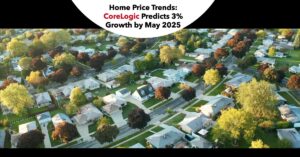Through May 2024, the U.S. housing market experienced significant changes. Home prices nationwide, including distressed sales, increased by 4.9% year over year in May 2024 compared to May 2023. Month-over-month, there was a 0.6% growth from April 2024 to May 2024. CoreLogic updates their results regularly to ensure accuracy, incorporating newly released public data.
Future Home Price Predictions 2024 to 2025
The CoreLogic Home Price Index (HPI) Forecast predicts that home prices will rise by 0.7% from May 2024 to June 2024. Over the year, from May 2024 to May 2025, a further increase of 3% is expected.
Key Insights from the Forecast
- Continued Annual Growth: May marked the 148th consecutive month of annual home price growth.
- Regional Variations: The Northeast led the country in annual appreciation, with New Hampshire recording a double-digit increase.
- Detached vs. Attached Homes: Detached homes continued to outpace attached homes in price growth, reflecting homebuyer preferences for more personal space and the impact of rising HOA fees.
Factors Influencing Market Dynamics
Dr. Selma Hepp, Chief Economist for CoreLogic, provided insights into the current market trends. She noted that national annual home price growth is slowing as anticipated, with the recent surge in mortgage rates contributing to this trend.
However, some markets, especially those with inventory levels below pre-pandemic figures, like the Northeast, continue to see robust price gains. More affordable regions, such as the Midwest, have also experienced healthy price growth. Conversely, areas with significant inventory increases, like Florida and Texas, are seeing deceleration in home prices.
State-by-State Analysis
According to CoreLogic's HPI, no states experienced a decline in home prices year over year in May 2024. The states with the highest increases were:
- New Hampshire: 12% increase
- New Jersey and Rhode Island: Both up by 9.8%
Top 10 Metro Areas
CoreLogic's HPI also highlights home price changes in select large metro areas for May 2024. San Diego saw the highest gain, with a 9.2% increase year over year.
Markets at Risk of Price Decline
CoreLogic's Market Risk Indicator (MRI) identifies areas at high risk of home price declines over the next 12 months. The top markets at risk include:
- Palm Bay-Titusville-Melbourne, FL: 70%-plus probability of price decline
- Gainesville, FL
- Atlanta-Sandy Springs-Roswell, GA
- Spokane-Spokane Valley, WA
- North Port-Sarasota-Bradenton, FL
Impact of Mortgage Rates
Mortgage rates have a profound impact on home prices. The surge in mortgage rates this spring has led to both a slowdown in homebuyer demand and a cooling of prices in many markets. For instance, areas that had been experiencing rapid price growth have seen a notable deceleration as higher borrowing costs deter potential buyers. This trend highlights the sensitivity of the housing market to changes in financing costs and underscores the importance of monitoring mortgage rates closely.
Inventory Levels and Market Health
Inventory levels play a crucial role in determining home price trends. Markets with inventory levels below pre-pandemic figures, such as those in the Northeast, continue to witness stronger home price gains. This is due to the imbalance between supply and demand, which pushes prices upward. Conversely, markets with increased inventory, such as parts of Florida and Texas, are experiencing a deceleration in price growth. This demonstrates the importance of inventory levels in shaping local market conditions.
Affordable Markets Showing Growth
Affordable markets, particularly in the Midwest, have shown healthy price growth this spring. These regions offer more accessible entry points for homebuyers, making them attractive in the current economic climate. As homebuyers seek out more affordable options, these markets have benefited from increased demand, driving up prices. This trend underscores the ongoing affordability challenges in more expensive markets and highlights the appeal of more reasonably priced areas.
Summary
To sum up, the U.S. housing market remains dynamic, with varying trends across different regions and market segments. While some areas continue to experience strong price growth, others are facing potential declines. CoreLogic's data provides valuable insights for homeowners, buyers, and realtors to navigate the changing market landscape.
The coming year will be crucial for monitoring these trends and making informed decisions based on the latest data. Whether you are looking to buy, sell, or invest, understanding these market dynamics will help you make the best choices in this evolving real estate environment.
By keeping a close eye on factors such as mortgage rates, inventory levels, and regional variations, stakeholders can better anticipate market movements and adjust their strategies accordingly. The insights provided by CoreLogic are essential tools for anyone involved in the real estate market, ensuring that you stay ahead of the curve and make decisions that align with your financial goals.
ALSO READ:
- Hottest Housing Markets Predicted for 2024
- Housing Market Predictions for Next 5 Years (2024-2028)
- Housing Market Predictions for the Next 2 Years
- Housing Market Predictions: 8 of Next 10 Years Poised for Gains
- Housing Market Predictions: Top 5 Most Priciest Markets of 2024
- Real Estate Forecast Next 5 Years: Top 5 Future Predictions











